|
 |
 |
|
The Dope on Nicotine
by Rochelle Schwartz-Bloom and Gayle Gross de Núñez
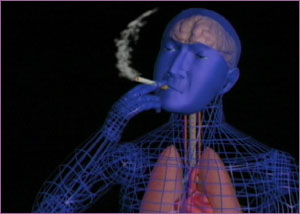
If it weren't for nicotine, people wouldn't smoke tobacco. Why? Because of the
more than 4,000 chemicals in tobacco smoke, nicotine is the primary one that
acts on the brain, altering people's moods, appetites, and alertness in ways
they find pleasant and beneficial. As the noted tobacco researcher M.A.H.
Russell once wrote,
"There is little doubt that if it were not for the nicotine in tobacco smoke,
people would be little more inclined to smoke than they are to blow bubbles or
to light sparklers."*
Unfortunately, as is widely known, nicotine has a dark side: It is highly
addictive. Once smokers become hooked on it, they must get their fix of it
regularly, sometimes several dozen times a day. Cigarette smoke contains 43
known carcinogens, which means that long-term smoking can amount to a death
sentence. In the U.S. alone, 420,000 Americans die every year from
tobacco-related illnesses.
Breaking nicotine addiction is not easy. Each year, nearly 35 million people
make a concerted effort to quit smoking. Sadly, less than 7 percent succeed in
abstaining for more than a year; most start smoking again within days.
So what is nicotine, and how does it insinuate itself into the smoker's brain and very being? Here, follow the trail nicotine blazes through the body,
from mouth to brain.
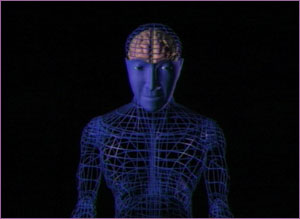
Drug
Like cocaine derived from coca leaves and morphine drawn from opium poppies,
the nicotine found in tobacco is a potent drug. Smokers, and even some
scientists, say it offers certain benefits. One is enhanced performance. One
study found that nonsmokers given doses of nicotine typed about 5 percent
faster than they did without it. To greater or lesser degrees, users also say
nicotine helps them to maintain concentration, reduce anxiety, relieve pain,
and even dampen their appetites (thus helping in weight control).
Unfortunately, nicotine can also produce deleterious effects beyond addiction.
At high doses, as are achieved from tobacco products, it can cause high blood
pressure, distress in the respiratory and gastrointestinal systems, and an
increase in susceptibility to seizures and hypothermia.
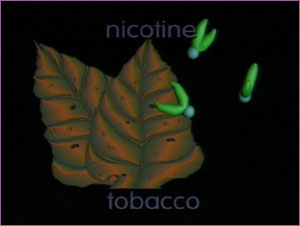
Nicotine
First isolated as a chemical compound in 1828, nicotine is a clear, naturally
occurring liquid that turns brown when burned and smells like tobacco when
exposed to air. It is found in several species of plants, including tobacco
and, perhaps surprisingly, in tomatoes, potatoes, and eggplant (though in
extremely low quantities that are pharmacologically insignificant for humans).
In tobacco, the highest concentration of nicotine appears in the plant's
topmost leaves. A poisonous alkaloid, nicotine at high dosages has been used in
everything from insecticides to darts designed to bring down elephants.

Cigarette
As simple as it looks, the cigarette is a highly engineered nicotine-delivery
device. For instance, when tobacco researchers found that much of the nicotine
in a cigarette wasn't released when burned but rather remained chemically bound
within the tobacco leaf, they began adding substances such as ammonia to
cigarette tobacco to release more nicotine. Ammonia helps keep nicotine in its
basic form, which is more readily vaporized by the intense heat of the burning
cigarette than the acidic form. Most cigarettes for sale in the U.S. today
contain 10 milligrams or more of nicotine. By inhaling smoke from a lighted
cigarette, the average smoker takes in one to two milligrams of vaporized
nicotine per cigarette.
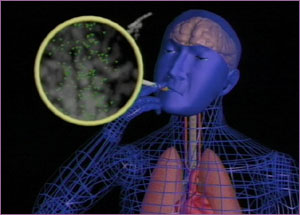
Addiction
As early as the 16th century, it was known that tobacco use led to
addiction. In 1527, the Spanish historian Bartolomé de Las Casas wrote,
"I have known Spaniards on the island of Hispaniola, who were accustomed to
taking [cigars] and who, being reproved and told that this was a vice, replied
that they were not able to stop." Today, we know that nicotine is the cause of
this dependency, and only a miniscule amount is needed to fuel addiction.
Research suggests that manufacturers would have to cut nicotine levels in a
typical cigarette by 95 percent to forestall its power to addict.
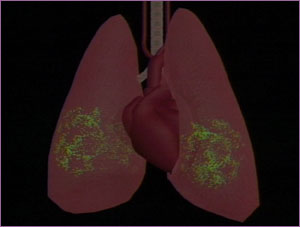
Heart and Lungs
When a smoker puffs on a lighted cigarette, smoke, including vaporized
nicotine, is drawn into the mouth. The skin and mucosal lining of the mouth
absorb some nicotine, but the remainder flows straight down into the lungs,
where it easily diffuses into the blood vessels lining the lung walls. The
blood vessels carry the nicotine to the heart, which then pumps it directly to
the brain. While most of the effects a smoker seeks occur in the brain, the
heart takes a hit as well. Studies have shown that a smoker's first cigarette
of the day can increase his or her heart rate by 10 to 20 beats a
minute.
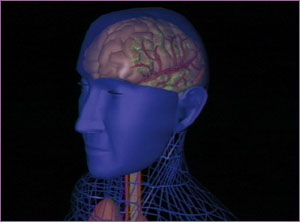
Brain
Scientists have found that a smoked substance reaches the brain more quickly
than one swallowed, snorted (such as cocaine powder), or even injected. Indeed,
a nicotine molecule inhaled in smoke will reach the brain within 10 seconds.
The nicotine travels through blood vessels, which branch out into capillaries
within the brain. Capillaries normally carry nutrients, but they readily
accommodate nicotine molecules as well. Once inside the brain, nicotine, like
most addictive drugs, triggers the release of chemicals associated with
euphoria and pleasure.
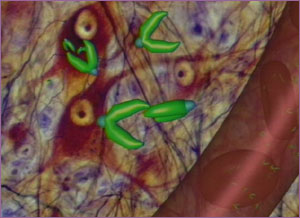
Neurons
Just as it moves rapidly from the lungs into the bloodstream, nicotine (shown
here as green chevrons) also easily diffuses through capillary walls. It then
migrates to the spaces surrounding neurons—gangly cells that transmit nerve
impulses throughout the nervous system. These impulses are the basis of our
thoughts, feelings, and moods.
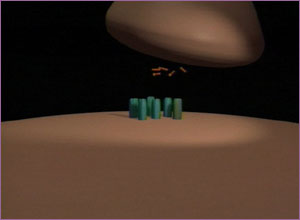
Neurotransmitters
To transmit nerve impulses to its neighbor, a neuron releases chemical
messengers known as neurotransmitters (shown here as orange bars). Like
nicotine molecules, the neurotransmitters drift into the so-called synaptic
space between neurons, ready to latch onto the receiving neuron and thus
deliver a chemical 'message' that triggers an electrical impulse.
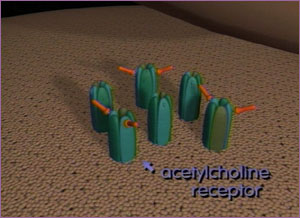
Receptors
The neurotransmitters—in our example, acetylcholine, a common variety—bind onto receptors (shown here as green blossoms) on the surface of the
recipient neuron. This opens channels in the cell surface through which enter
ions, or charged atoms, of sodium (see white dots). This generates a current
across the membrane of the receiving cell, which completes delivery of the
'message.'
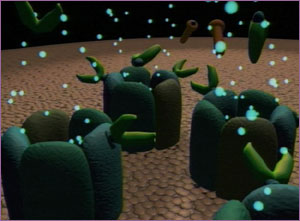
Binding
An accomplished mimic, nicotine competes with acetylcholine to bind to the
acetylcholine receptor. It wins and, like the vanquished chemical, opens ion
channels that let sodium ions into the cell. But there's a lot more nicotine
around than acetylcholine, so a much larger current spreads across the
membrane. This bigger current causes increased electrical impulses to travel
along certain neurons. With repeated smoking, the neurons adapt to this
increased electrical activity, and the smoker becomes dependent upon the
nicotine.
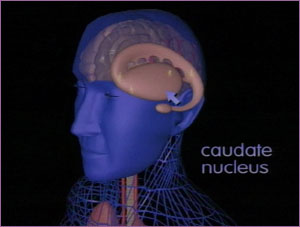
Caudate Nucleus
The caudate nucleus, an area of the brain that controls voluntary movement,
illustrates this adaptation. Without the nicotine, neurons cannot maintain
impulses at the levels they had previously. As a result, some smokers
experience hand tremors between cigarettes. These "smoker's tremors" may be
hard to see, because a smoker hides them by smoking another cigarette. The
tremors may be a sign of withdrawal, but they will go away if the smoker gives
up smoking for good.
*M.A.H. Russell, "The Smoking Habit and Its Classification, The Practitioner 212 (1974): 793.

Rochelle Schwartz-Bloom |
|

Gayle Gross de Núñez |
|
Dr. Rochelle D. Schwartz-Bloom is a professor of pharmacology in the Department
of Pharmacology and Cancer Biology, Duke University Medical Center, and
president of Savantes, a company in Durham, N.C. that produces science
education materials. Dr. Gayle Gross de Núñez is director of
Cajal Illustration, Chicago, Illinois. The pair coproduced the video program
"Animated Neuroscience and the Action of Nicotine, Cocaine, and Marijuana in
the Brain," from which this piece was adapted and expanded. For information on
ordering the video, contact Films for the Humanities & Sciences of
Princeton, N.J. at www.films.com. |
Anatomy of a Cigarette |
"Safer" Cigarettes: A History |
The Dope on Nicotine |
On Fire
Resources |
Teacher's Guide |
Transcript |
Site Map |
Search for a Safe Cigarette Home
Search |
Site Map |
Previously Featured |
Schedule |
Feedback |
Teachers |
Shop
Join Us/E-Mail |
About NOVA |
Editor's Picks |
Watch NOVAs online |
To print
PBS Online |
NOVA Online |
WGBH
© | Updated October 2001
|
|
|
|